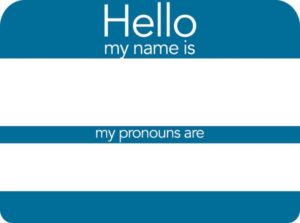By Sierra Voorhies
 When someone uses she/her pronouns, you might assume she’s a woman, but pronouns and gender do not always match. Sharing and asking for someone’s pronouns is becoming more common, so it’s a good time to address the common misconception that gender and pronouns are synonymous. I’ll start with explaining sex versus gender.
When someone uses she/her pronouns, you might assume she’s a woman, but pronouns and gender do not always match. Sharing and asking for someone’s pronouns is becoming more common, so it’s a good time to address the common misconception that gender and pronouns are synonymous. I’ll start with explaining sex versus gender.
Sex is determined by a combination of all sexual characteristics: chromosomes, hormones, and internal and external sex organs (for example ovaries, penis, vulva). If one were to ask what your sex is, they would be referring to your physical sex makeup, and one would respond female, intersex, or male. Check out Aurora’s last blog to learn about what it means to be intersex!
Sex is connected to gender, but they are not the same. Someone’s gender is how they fit into the socialized perceptions of femininity and masculinity. Genders include but are not limited to:
- cisgender (or cis): when one’s gender identity aligns with the sex they were assigned at birth (e.g., a woman who was assigned female at birth).
- transgender (or trans): when one’s gender identity does not align with the sex they were assigned at birth (e.g., a man who was assigned female at birth).
- non-binary or genderqueer: when one’s gender identity is not only or completely either a woman or a man. Someone who is non-binary or genderqueer may be in between a man and a woman, complete outside of those two genders, or some combination of the two.
- genderfluid: when one’s gender identity or presentation changes over time. Some genderfluid people flip between genders day to day, others shift gradually from one to another. There are no rules!
- agender: when one does not identify with any gender.
Many non-binary, genderqueer, and genderfluid people identify themselves as trans (under the trans umbrella) because their gender does not fully align with their sex assigned at birth. The non-binary identity is also considered an umbrella under which other, more specific identities may fall. And keep in mind that gender labels are a tool for people to communicate their own identities: listen to gender non-conforming people, they may deviate from these definitions or labels and that’s okay.

Finally, why are we all here, pronouns! Pronouns are the gendered terms we use to refer to people when not using their name (e.g., he/him, she/her, they/them). Pronouns are connected to gender, but are also not the same. Most importantly, pronouns don’t dictate gender and vice versa. This means that no matter what someone’s pronouns are, you can’t use them to assume their gender; and you can’t use someone’s gender to assume their pronouns. For example, a non-binary person might use he/him pronouns because they are not ready to come out, because they are comfortable with them, or for many other reasons. A woman I know goes by both she/her and they/them (yes, people can use multiple!) so their pronouns are she/they.
As we continue to ask for people’s pronouns, it’s important to note that it’s not appropriate to use that information to assume someone’s gender or sex. It’s always polite and appropriate to ask for pronouns at the beginning of a new conversation with someone, and if you have known someone a long time, it’s good to check in and ask now as well! I hope this blog is helpful, and we can continue to make mistakes, grow, and learn together.